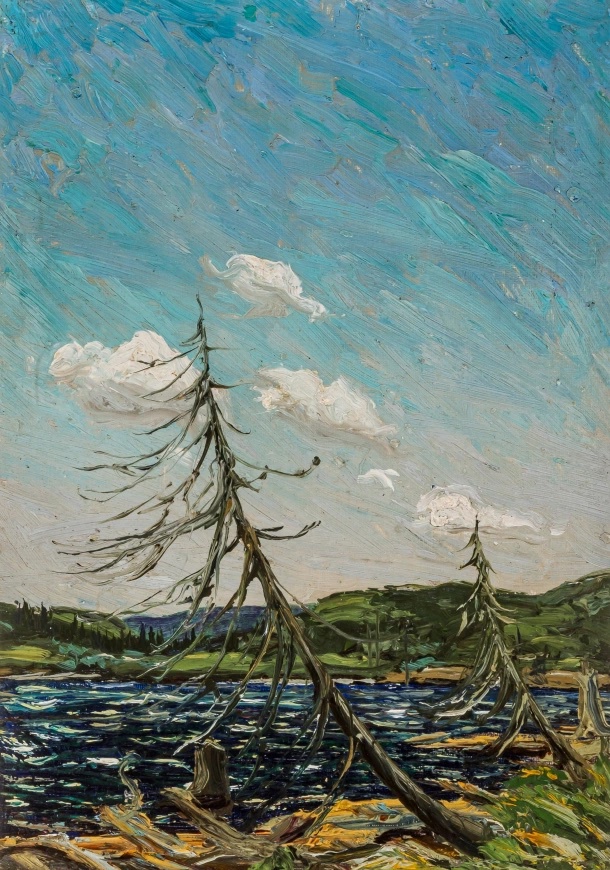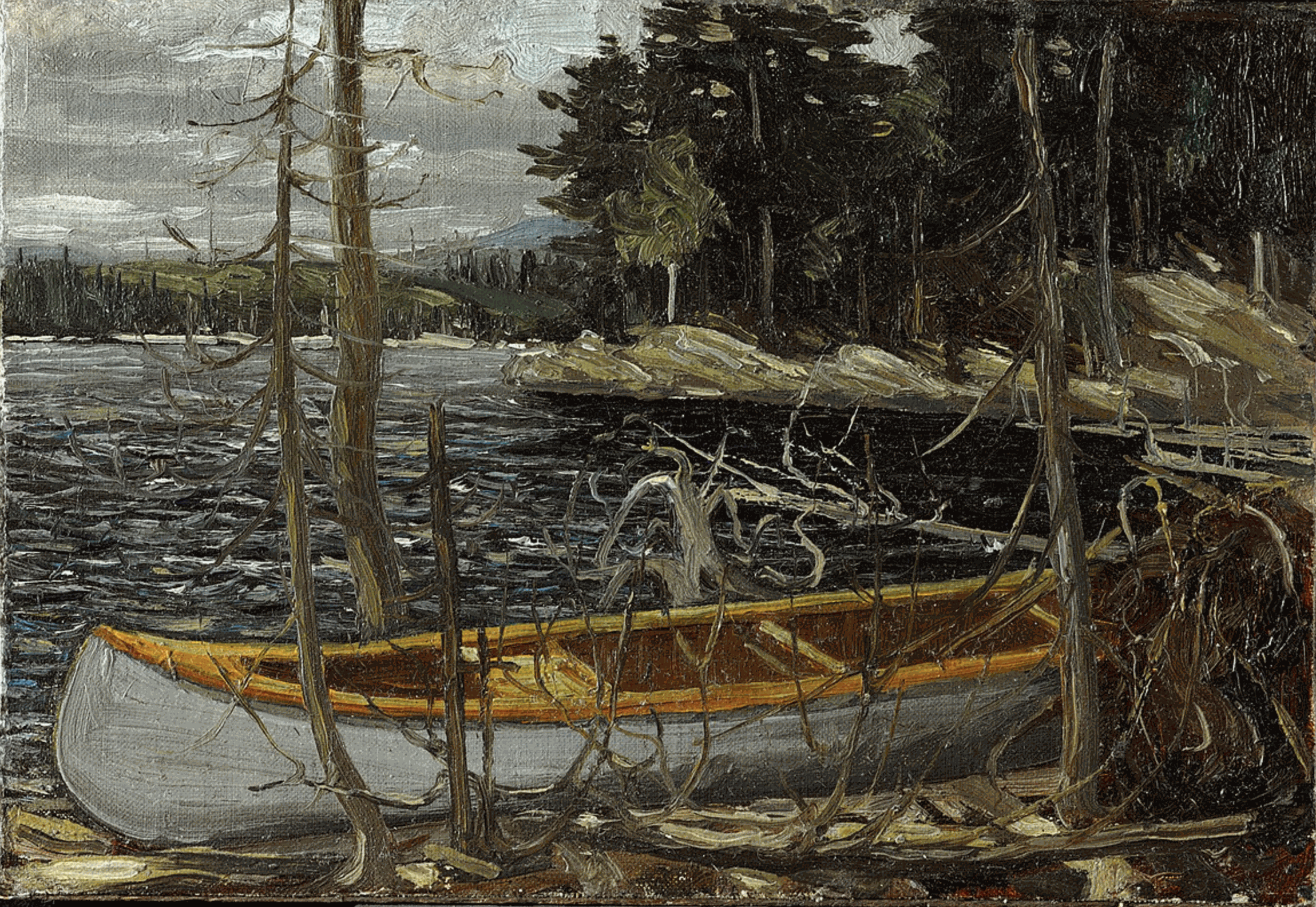Tom Thomson: A centrepiece for your collection

Tom Thomson (1877-1917)
Northern Lake, 1912
Oil on panel, 10 x 7 in., 25.4 x 17.8 cm
Tom Thomson Catalogue Raisonne (Joan Murray) no. 1912.15
Tom Thomson was always drawn to the subject of trees; trees with spreading foliage beside streams, trees blown by the wind and bent over lakes; trees that many people didn't look at or saw only as objects to be removed or "tidied up." In Algonquin Park, where he spent most of the year, Thomson painted trees as though collecting different varieties offered by the environment. Thomson painted the subject in views with such loving attention to light, space and topography that it took on a grandeur and meaning for all Canadians. Sometimes the subject offered a spectral silence. But sometimes, as in this painting, viewers can almost hear the sound of the wind summoned by the image. Thomson loved trees from his earliest days as an artist. In his days at Grip Engraving Ltd., where he was hired as a commercial artist in the design section in 1909, and likely even before, he would have heard about the art director Albert H. Robson, one of the top men in the field and himself a painter.

Tom Thomson, Northern Lake, 1912, projected onto a virtual wall.
Robson was a man with a powerful desire to see Grip gain a large section of the Canadian advertising market by offering work in competition with New York, where much of the business of the day was handled. To do that, he believed that the artists of the company had to discover imagery which would suggest the "true spirit" of the country. From 1905 on, he encouraged them to take an interest in painting landscape and suggested that they take weekend sketching trips to discover picturesque environs. They did so, bringing their work into Grip for the criticism of their peers to such a point that Robson had to remind them he "wasn't running an art school." From around 1910, Thomson followed Robson's directive, taking sketching trips during which he painted images with a northern feel, though not actually painted "up north."
In 1911, he traveled to such locations as Owen Sound and Lake Scugog; in 1912, to Algonquin Park and then by canoe, with a colleague from Grip, to the area northwest of Sudbury, through Biscotasing, Spanish Lake, the Mississagi Forest Reserve and ending at Squaw Chute. Possibly this sketch was painted on his trip to Mississagi in 1912. He may have looked with interest at his depiction in this sketch of a wind-blown lake and foreground tree stump when painting his first major canvas Northern Lake (Art Gallery of Ontario, Toronto) in Toronto the following winter. Thomson's work of 1912 was important: it was a catalyst to his - and the Group of Seven's - later development. When Thomson showed the small panels painted in 1912 to his peers at Grip, he was strongly encouraged to continue traveling to discover new imagery. Such praise as he received also came from a new acquaintance he made that year, Dr. J. M. MacCallum, an ophthalmologist, who became his patron. Much later, in 1918, MacCallum wrote that the little panels by Thomson were dark and muddy in colour, but truthful in feeling (Tom Thomson: Painter of the North," Canadian Magazine 50, no. 5, March 1918, p. 376). This sketch must have been one of his brightest of that year.
Northern Lake shows us Thomson at this moment in his work when he was discovering what was for him a new world. In the scene he avoided the conventionally picturesque by painting a scene directly from nature and one of great simplicity. Here, the trees are so bent by the wind that they seem almost ready to fall over - a powerful reminder of weather in the north. Along with the underbrush and stumps of trees, they form rhythmic repeats which are echoed in places by strokes of paint Thomson used in the sky. The fanciful small white clouds, the foamy wavelets on the water, and the beautiful colour shading from cerulean blue, through turquoise, lavender, to pink, make the image fresh and resonant. The viewer has the feeling that the doors of perception have been cleansed - and can understand the way Thomson's peers felt when they saw images such as this.
The handling of paint in the work is one that Thomson would later develop with greater sureness of touch. On top of an undercoat of paint, he laid patches of colour to indicate sunlight. He would later use the same effect, greatly elaborated, in his large paintings with their multilayered surfaces and vibrant effects.
Thomson gave this sketch to Thoreau MacDonald in about 1915 or 1916, as Thoreau's inscription reads on the verso, when MacDonald was fifteen or sixteen. J.E.H. MacDonald, Thoreau's father, had been the head of the Design section at Grip, Thomson's section, and the two men had fast become friends. Thomson came often to the MacDonald household to help MacDonald Senior finish jobs in commercial design by working all night, and visited with him for social reasons on other occasions. Later Thoreau visited Thomson in the shack behind the Studio building on Severn Street where Thomson lived and worked.
 Alan Klinkhoff Gallery note: The verso of Tom Thomson’s Northern Lake contains hand-written inscriptions by Thoreau MacDonald (top), and A.Y. Jackson (middle). It is unusual for a Thomson sketch to have the estate stamp when the work was not in Thomson’s estate when the artist passed away. As Thoreau MacDonald’s inscription recalls, the painting was gifted to him by Thomson in 1915 or 1916. It was his father, J.E.H. MacDonald, who designed the Tom Thomson Estate Stamp in 1917. Thoreau Macdonald recalled stamping some of the sketches, and the stamp remained in his possession after his father passed away.
Alan Klinkhoff Gallery note: The verso of Tom Thomson’s Northern Lake contains hand-written inscriptions by Thoreau MacDonald (top), and A.Y. Jackson (middle). It is unusual for a Thomson sketch to have the estate stamp when the work was not in Thomson’s estate when the artist passed away. As Thoreau MacDonald’s inscription recalls, the painting was gifted to him by Thomson in 1915 or 1916. It was his father, J.E.H. MacDonald, who designed the Tom Thomson Estate Stamp in 1917. Thoreau Macdonald recalled stamping some of the sketches, and the stamp remained in his possession after his father passed away.
As Thoreau wrote in his account of his visits, he was more interested in the canoe paddles and axe handles that Thomson made and finished in intervals between paintings than in the paintings by Thomson (his account appears in the appendix of O. Addison's Tom Thomson: The Algonquin Years, of 1969). Thomson gave him a couple of axe handles, he recalled. Thomson likely gave this sketch to Thoreau to show him what the landscape looked like up north, but he would have made sure the sketch was a good one due to his friendship and respect for Thoreau and his father. Thomson gave Thoreau other sketches too, including one he painted of Thoreau, titled Day-Dreaming. ("Looks about 1913 or 1914," Thoreau wrote laconically on the verso.) Later, Northern Lake was owned by Dr. Max Stern. A.Y. Jackson, always helpful where the placement of Thomson's work was concerned, may have brought it to Stern's attention - hence, Jackson's writing on the verso.

Alan Klinkhoff Gallery note: Thomson’s iconic painting, The Canoe (Art Gallery of Ontario), pictured here, is closely related stylistically to Northern Lake, 1912.
In time, Thomson graduated from the sketch medium to canvases which carry the full quality of his message, but his message still concerned the discovery of something miraculous and beautiful in the northern landscape. His masterpieces such as The Jack Pine capture the pattern of the woods, how trees and foliage point, tilt, seem to signal, and he conveyed these forms without affectation. The origin of his thoughts about the wiry compositions trees can offer lies in sketches such as Northern Lake. It is small, but awesome, and in it, the viewer may find, is the spirit of Canada.
Joan Murray
Joan Murray, the author of Tom Thomson: Trees, The Best of the Group of Seven, Northern Lights: Masterpieces of Tom Thomson and the Group of Seven, Kurelek’s Vision of Canada, and many others, has had a curatorial, scholarly and administrative career spanning over 30 years, at the Art Gallery of Ontario (1968-1973) and the Robert McLaughlin Gallery of Oshawa where she was director from 1974 to 2000.





